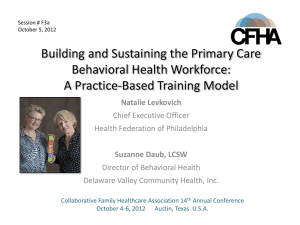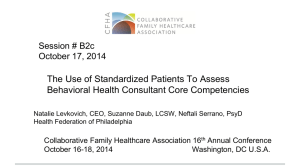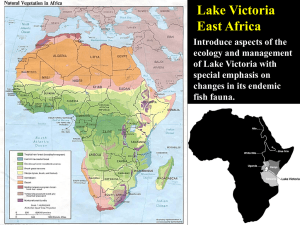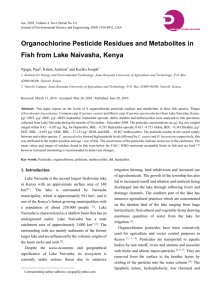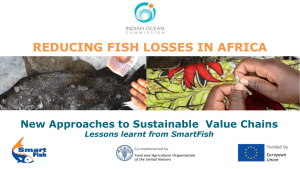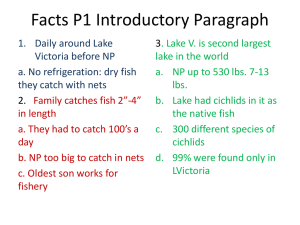International Symposium Field Toxicology
advertisement
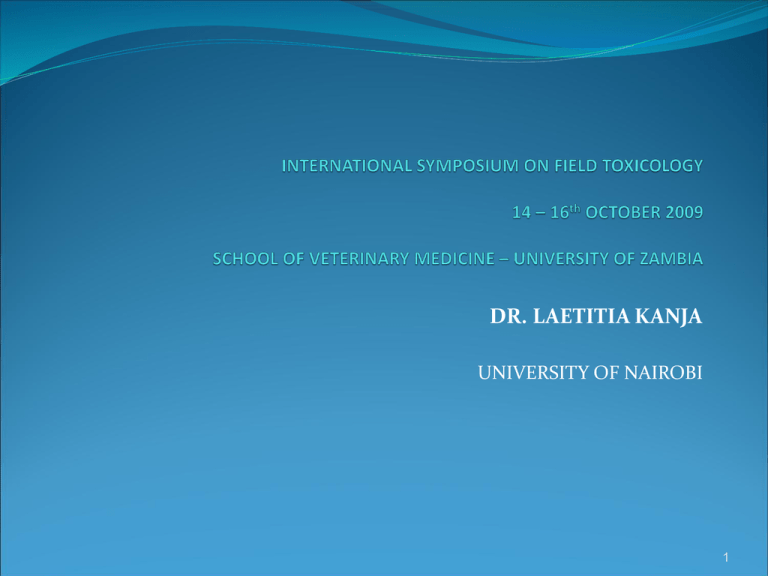
DR. LAETITIA KANJA UNIVERSITY OF NAIROBI 1 Mwangi M. C1, Karuri E. G2 and Kanja L. W3 1Department of the National Public Health Laboratory Service, Ministry of Health, Kenya of Food Technology & Nutrition, College of Agriculture and Veterinary Sciences, University of Nairobi 3Department of Public Health, Pharmacology and Toxicology, College of Agriculture and Veterinary Sciences, University of Nairobi 2Department 2 INTRODUCTION Nile Perch in Lake Victoria: Largest fresh water lake in Africa and covers a surface area of 68,800km2 and an average depth of 40m. With Kenya taking up 6%, Tanzania 49%, Uganda 45% of the total lake area. Nile Perch (Lates niloticus) dominates the lake forming about 50% of the entire fish populations About 52% of the total perch fillet produced in Kenya is exported to the European Union (EU) market and other countries. The lake experiences environmental influence from the three riparian states, where agricultural chemicals and industrial effluents are known to contribute significantly to the lake pollution 3 • Previous studies in Kenya had shown cases of organochlorine pesticide residue in fish from the Lake Victoria and other Kenyan lakes (Koeman et al, 1972, Lincer et al 1981,Mugachia et al 1992, Wandiga et al 2002). • Environment pollution and the subsequent water contamination in the Lake Victoria, and poor sanitary conditions at the landing facilities led fish export bans by the EU market between 1996 and 1999 This had a negative effect on the EU market, the fishing community’s livelihoods and other stakeholders. 4 Objectives of the study: The objective of this study was to identify and quantify the organochlorine pesticide residues in Nile Perch fish tissues. 5 MATERIALS AND METHODS Sampling Fish samples (about 1.5kg each and approximately 6-8 months old) were purchased from five landing facilities along the Kenyan shore line Liver and muscle samples were obtained from each fish and wrapped in foil and kept frozen. Sample analysis Extraction, clean-up and analysis of organochroline pesticide residues was done as described by Brevik (1981) 3g of the sample were extracted with diethylether extracts and 2 aliquots of the extract treated with concentrated sulphuric acid and methanolic potassium hydroxide, and analysed by gas liquid chromatography (GLC). 6 RESULTS A total of 125 fish liver and muscle samples were analyzed for organochlorine pesticide residues. The results are presented in Figures 1, 2 ,3,4 and 5. The residue concentrations of the pesticides are presented on wet weight basis. Eleven organochlorine pesticide residues were detected in the liver tissue and nine in the fish muscle. 7 400 350 α =BHC β =BHC γ =BHC Heptachlor Hept Epox Aldrin Dieldrin Endrin p,p'-DDE p,p'-DDT o,p'-DDD Mean Values 300 250 200 150 100 50 0 February (n=9) March (n=17) April (n=13) May (n=7) June (n=5) Period of Sampling Figure 1: Mean pesticide residue levels (µg/kg) in Nile perch liver, 2001 8 100 90 α =BHC 80 β =BHC Mean Values 70 γ =BHC 60 Hept Epox 50 Aldrin Dieldrin 40 Endrin 30 p,p'-DDE 20 10 0 February (n=11) March (n=14) April (n=15) May (n=9) June (n=3) Period of Sampling Figure 2: M ean pesticide residue levels (µg/kg) in Nile perch muscle, 2001 9 250 Mean Values 200 α =BHC β =BHC γ =BHC 150 Heptachlor Hept Epox Aldrin Dieldrin 100 Endrin p,p'-DDE 50 p,p'-DDT 0 FebruaryJune:Liver (n=51) FebruaryJune:Muscle (n=52) Period of Sampling Figure 3:M ean pesticide residue levels (µg/kg) in Nile perch liver and muscle samples, February – June 2001 10 4500 4000 α =BHC 3500 Mean Values β =BHC 3000 γ =BHC 2500 Heptachlor Hept Epox 2000 Aldrin Dieldrin 1500 Endrin 1000 p,p'-DDE 500 0 October: Liver (n=3) Muscle (n=3) November: Liver (n=8) Muscle (n=8) Period of Sampling Figure 4: Mean Pesticide residue Levels in Nile Perch Liver and Muscle– October and November 2000 11 Monthly Rainfall 180 169.7 160 140 Line 1 Mean Values 129.8 120 116.7 104 100 80 77.5 74.7 Poly. (Line 1) 60 40 36.2 20 0 October November February March April May June Period of Sampling - Year 2000/2001 Figure 5: Monthly mean rainfall (mm) 12 Conclusion The study established that the landed Nile Perch fish investigated were contaminated with organochlorine pesticide residues. The EU concerns over the possible contamination of fish by poisonous chemicals were justified. The levels were high enough for action to be taken by the relevant authorities. 13 Recommendations 1. Continuous monitoring of chemical residue analysis of the lake environment would help to determine whether pollution is seasonal or sporadic. 2. The source of pollution should be clearly established . 3. Collaborative studies on lake pollution should be initiated among the riparian states. 14 REFERENCES Brevik, E. M. (1978) Organochlorines in fish and crabs from the Kristiansand Fjord in Norway, Nord. Vet. – Med. 30, 375- 379. Kanja L.W. (1988) Organochlorine pesticides in Kenyan mothers’ milk: Levels and Sources. Ph. D. thesis. University of Nairobi. Koeman, J. H. (1972). Apreliminary survey of the possible contamination of Lake Nakuru in Kenya with some metals and chlorinated hydrocarbon pesticides. J. Appl. Ecol., 9: 411-416 Bulkley, R. V., Leung, S. Y. T. and Richard, J. J., 1981. Organochlorine insecticide concentrations in fish of the Des Moines River, IOWA, 1977-78, Pestic. Monit. J., 15, 86. Lincer, J. L.; Zalkind, D.; Brown, L. H.; Hopcraft, J. 1981 Organochlorine residues in Kenya’s Rift Valley lakes J. Appl. Ecol., 18: 157-171. Mugachia, J.C, Kanja, L. and Gitau F., 1992. Organochlorine Pesticide Residues in Fish from Lake Naivasha and Tana River, Kenya. Bull. Environ. Contam. Toxicol.) 49:207-210. 1192 Springer- Verlag New York Inc. Mwangi C. M. (2003) Quality of Lake Victoria Nile Perch (Lates niloticus) at the Landing Facility as a Potential Microbiological and Organochlorine Pesticide Residue Hazards Critical Control Point MSc Thesis. University of Nairobi, Kenya Wandiga, S. O.; Yugi, P.O.; Barasa, M. W.; Jumba, I. O.; Lalah, J.O. (2002) The distribution of organochlorine pesticides in marine samples along the Indian Coast of Kenya. 15 ACKNOWLEDGEMENT The authors are grateful to the Swedish International Development Authority (SIDA) for financial support. 16 THE END. THANK YOU. 17

